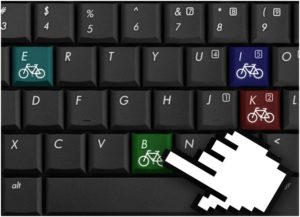Buying or renewing a bike insurance is a click away: 10 Benefits to Go Online
 In today’s internet savvy world, we all purchase something or the other online. From apparels, airline tickets, to gadgets, literally EVERYTHING is only a few clicks away! Even while writing this article, I ordered for a purple kurta to be worn in my office Holi party!
In today’s internet savvy world, we all purchase something or the other online. From apparels, airline tickets, to gadgets, literally EVERYTHING is only a few clicks away! Even while writing this article, I ordered for a purple kurta to be worn in my office Holi party!
In fact, it’s not just clothes and groceries that are selling like hotcakes in the internet world, as people are buying insurance online as well.
Either you or someone in your acquaintance might have bought bike insurance online. After all, as per the research across 18 cities, more and more people are buying insurance online. Of the 3007 respondents,24% purchased motor insurance online.
However, if you are reluctant about going ahead with the online mode and prefer the conventional mode of arranging a meeting with various insurance agents and visiting their offices for detailed discussion, this article is meant just for YOU!
Benefits of online buying/renewing bike insurance:
Buying or renewing bike insurance online can prove advantageous in various ways, such as:
1. Automated servicing: The online platform is not meant for buying insurance only. As a prompt and efficient servicing channel, current policyholders can adopt the online mode to renew their policy as well, regardless of whether they purchased their policy online or not. Further, with just one click, you can download product literature like brochures, policy wordings, etc. and get instant premium quotes online.
2. Online assistance: If you are purchasing the insurance online, it doesn’t mean you will not get any assistance. Most of the insurance companies have live chat facility on their websites where customers can seek clarification in case of any query. Also, customers can call on the toll-free number of insurance companies to clear all doubts. You can go further and ask the insurer for a face-to-face meeting. The insurer will send an executive for further assistance.
3. Paperless transactions: Getting into paperwork is both time consuming and boring. But when you go online to buy an insurance policy, it requires just a few easy steps. Besides being efficient, you are protecting the Mother Nature by going paperless!
4. Time-saving and convenient: To purchase insurance offline, you need to go through the tedious task of filling long insurance forms. However, when you buy insurance online, you need to submit only a few details. Also, at the time of policy renewal, it’s easy to reload your information. As the insurer already has your details, you only need to submit your policy number. Further, insurance companies have designed an easy-to-understand user interface which has made the entire process of buying the insurance quicker and easier. And who wouldn’t love to cut the hassles of going out and standing in long queues, when buying and renewing of bike insurance can be done from the comfort of home. While watching the ‘Friends’ season on television, or during the office break or even from your mobile, bike insurance can be purchased in a hassle-free manner.
5. Cheaper premium rates: It is disheartening to see that nearly 75% of two-wheelers plying on roads are uninsured even when it is mandatory to have a third-party insurance to ply your vehicle on roads. Many times, people avoid the insurance to save some penny.However, buying a bike insurance online ensures additional savings. The insurance quotes are given for free, and in fact, you can ask for as many quotes as you want. Moreover, there is no obligation to purchase either! As there is no involvement of any agent and the insurer saves on paper and administrative cost, the same is passed on to policyholders in the form of cheaper premium rates.
6. Away from nasty agents: Though, an insurance agent plays an important role, sometimes they may not be helpful. Often, insurance agents prove to be pushy and may even have vested interests in a particular insurance policy. But when you go online, you get an option of comparing and choosing the right insurance policy after analyzing every aspect carefully. Also, there will be no interference or biased suggestion from insurance agents!
7. Instant policy issuance: When you buy a policy offline, the insurer takes a lot of time in processing physical documents. Whereas, in the internet world, the processing of information is instant and so is the issuance of your bike insurance.
8. Storage of policy documents at one place: When you go online, you will always have the soft copy of your insurance policy in your email. It means, you can access your policy anytime and anywhere. Did you know the Insurance Regulatory Authority of India (IRDAI) has introduced a digital motor insurance initiative known as e-VahanBima?It says that you don’t need to carry your motor insurance policy document every time you take out your vehicle on the road.
9. Check policy review: As you do it at the time of purchasing other things on the internet, you can check the reviews of previous customers and their experience with the insurance company before going ahead. It means, you can compare features of different policies and know about the reputation of a company before zeroing in on.
10. No impact of demonetisation: I know, the ‘demonetisation phase’ is over, but what if the government comes up with its second season? As it is said, ‘once bitten, twice shy’ so, go for the online mode to ensure that any cash crunch scenario doesn’t affect the process of buying or renewing bike insurance. All you would require doing is, log on to the insurer’s website and fill the important details, including policy information, vehicle registration number, add-ons, if any, and make payment via net banking.
Remember, accidents happen unannounced.Therefore, the least you can do is, apply for a comprehensive bike insurance that takes care of the associated expenses and ensures your financial security.
Further, it is reassuring to know that buying bike insurance online doesn’t pose any serious safety threats as every step is taken by an insurer to keep your personal information confidential.
















